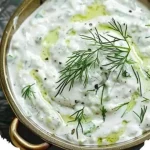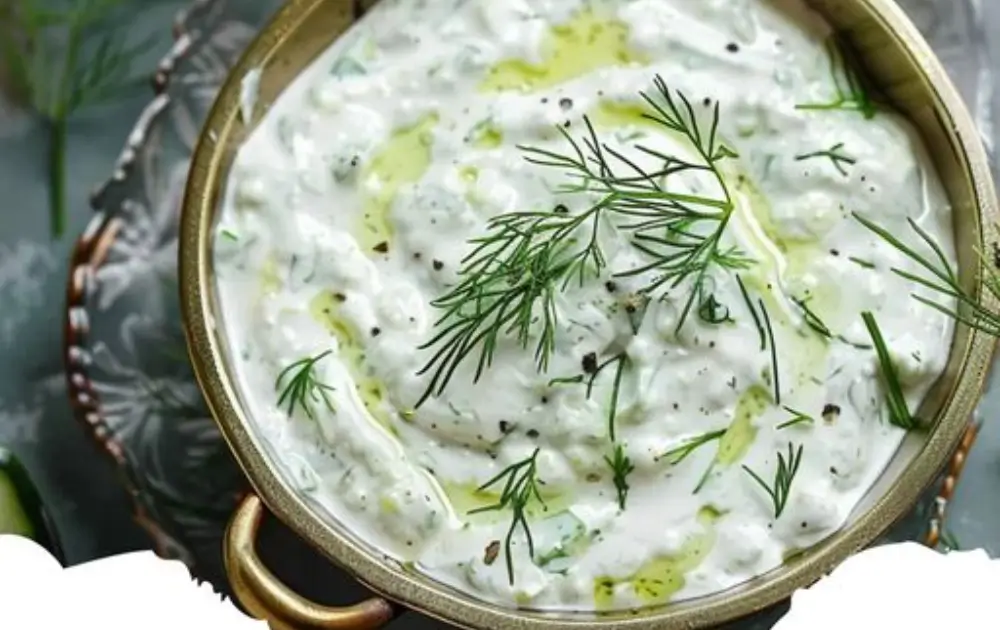Tzatziki sauce is a traditional Greek condiment known for its cool, creamy texture and refreshing taste. This sauce combines Greek yogurt, cucumbers, garlic, and herbs, typically dill or mint, to create a distinctive flavor profile. Commonly used as a dip, a spread for sandwiches, or a condiment for grilled meats, tzatziki is integral to Greek cuisine. It offers a balance to dishes with strong flavors or high spice levels, making it a favorite among those who appreciate its versatility and ease of preparation.
Print
Tzatziki Sauce
- Author: recipstep
- Total Time: 15 minutes
- Yield: Serves 4-6 1x
- Diet: Gluten Free
Ingredients
½ English cucumber
¼ cup fresh dill
1 garlic clove
1 1/2 cups plain Greek yogurt
½ lemon, juiced
Salt & pepper to taste
Instructions
Prepare Cucumber:
Peel and grate the cucumber.
Place the grated cucumber in a fine mesh sieve or colander and sprinkle with a pinch of salt. Allow it to sit for 10 minutes to release excess moisture.
After 10 minutes, squeeze the grated cucumber to remove any remaining water.
Prepare Dill and Garlic:
Finely chop the fresh dill.
Mince the garlic clove.
Mix Ingredients:
In a mixing bowl, combine the Greek yogurt, grated cucumber, chopped dill, minced garlic, and lemon juice.
Stir well to combine.
Season to Taste:
Add salt and pepper to taste. Stir again to ensure all ingredients are well incorporated.
Chill and Serve:
Cover the tzatziki sauce and refrigerate for at least 30 minutes before serving to allow the flavors to meld.
Serve chilled with your favorite dishes, such as grilled meats, vegetables, or as a dip with pita bread.
Notes
- For the best results, use full-fat Greek yogurt for a thicker, creamier texture.
- The sauce can be stored in the refrigerator in an airtight container for up to 4-5 days.
- Ensure to drain the cucumber thoroughly to prevent the sauce from becoming watery.
- Prep Time: 15 minutes
- Cook Time: 0 minutes
- Category: Sauce
- Method: Mixing
- Cuisine: Greek
Nutrition
- Calories: 70
- Sugar: 3g
- Sodium: 50mg
- Fat: 3g
- Saturated Fat: 1g
- Carbohydrates: 4g
- Fiber: 0.5g
- Protein: 6g
- Cholesterol: 5mg
Frequently Asked Questions about Tzatziki Sauce
- What is the best type of yogurt to use for Tzatziki? The best yogurt for Tzatziki is thick Greek yogurt, as it provides a creamy texture and tangy flavor essential for the authentic taste of the sauce.
- How long can you store Tzatziki Sauce in the refrigerator? Tzatziki Sauce can be stored in the refrigerator in an airtight container for up to 4–5 days. The flavors will continue to develop over the first day or so.
- Can Tzatziki Sauce be frozen? Freezing Tzatziki Sauce is not recommended, as it can cause the yogurt to separate and the cucumbers to become soggy when thawed.
- Is Tzatziki Sauce healthy? Yes, Tzatziki Sauce is considered healthy. It is low in calories, contains healthy fats from olive oil, and provides protein from Greek yogurt.
- What are some tips for getting the best flavor in Tzatziki Sauce? To achieve the best flavor, ensure you drain the cucumber well to prevent wateriness, use fresh garlic and herbs, and allow the sauce to chill for several hours before serving to meld the flavors.
Key Ingredients and Variations
The base ingredients for Tzatziki Sauce are straightforward, consisting of strained Greek yogurt, finely grated cucumber, garlic, olive oil, and fresh herbs. The yogurt should be thick to maintain the sauce’s creamy consistency, while the cucumber provides a fresh, crisp texture. Garlic adds a pungent kick, balanced by the herbal notes of dill or mint. Lemon juice or vinegar can be added for a slight tang. Some variations include adding lemon zest for a citrusy punch or using different herbs like parsley for a unique twist.
Preparation Techniques
Making tzatziki sauce involves several simple steps. First, the cucumber must be grated and thoroughly drained to remove excess water, which helps prevent the sauce from becoming too watery. The yogurt is typically mixed with a little olive oil to create a smooth, rich base. Finely minced or grated garlic and chopped herbs are then added to the yogurt mixture. For the best flavor, the sauce should be chilled for a few hours before serving to allow the flavors to meld.
Serving Suggestions
Tzatziki Sauce is incredibly versatile in its serving options. It is traditionally served as a dip with pita bread, fresh vegetables, or as part of a mezze platter. It also makes an excellent sauce for gyros, souvlaki, and other grilled meats, adding moisture and flavor. Additionally, tzatziki can be used as a healthy alternative to mayonnaise in sandwiches and wraps, providing a creamy texture with fewer calories and more nutritional benefits.
Cultural Significance
In Greek culture, tzatziki sauce is more than just a culinary staple; it is a part of social and familial gatherings. Often featured in traditional Greek feasts and celebrations, Tzatziki represents the Mediterranean ethos of using fresh, wholesome ingredients. It is commonly found in the cuisines of neighboring countries as well, each adding their own local variations to the basic recipe. The sauce’s presence in these diverse culinary traditions highlights its widespread appeal and adaptability to different tastes and dishes.
Health Benefits
Tzatziki Sauce is celebrated not only for its flavor but also for its health benefits. Greek yogurt, a primary ingredient, is rich in protein and probiotics, which are essential for digestive health. Cucumbers, being high in water content, contribute to hydration and are low in calories, making this sauce a diet-friendly option. The garlic in Tzatziki is known for its anti-inflammatory properties and ability to boost the immune system. Additionally, the herbs used in Tzatziki provide antioxidants, while olive oil offers healthy fats known to support heart health.
Adapting Tzatziki for Various Diets
Tzatziki Sauce can easily be adapted to suit various dietary needs. For those following a vegan diet, coconut yogurt or another non-dairy yogurt substitute can replace Greek yogurt to maintain a similar texture and tanginess. Individuals watching their sodium intake can limit the amount of added salt, and those with allergies to dairy can enjoy the sauce by choosing suitable yogurt alternatives. Furthermore, the sauce’s base of yogurt and cucumber makes it naturally gluten-free, catering to those with gluten sensitivities.
Cooking Tips for Perfect Tzatziki
Achieving the perfect Tzatziki Sauce involves a few key techniques. Ensuring the cucumber is well-drained is crucial; salt the grated cucumber and allow it to sit in a sieve for a few minutes to draw out moisture before squeezing the excess liquid out. This step helps maintain the sauce’s creamy consistency without becoming watery. Using freshly minced garlic and herbs rather than dried will enhance the sauce’s vibrant flavor. Lastly, chilling Tzatziki for at least two hours before serving allows the garlic and herbs to infuse the yogurt fully.
Innovative Uses of Tzatziki in Cooking
Beyond its traditional uses, Tzatziki Sauce can be incorporated into various dishes to add a creamy, flavorful element. It makes a refreshing dressing for summer salads or a cooling topping for spicy dishes, such as Indian curries or spicy Mexican tacos, balancing out the heat. Tzatziki can also be used as a base for marinades, tenderizing and adding moisture to chicken or lamb before grilling. Moreover, creative chefs use Tzatziki as a sauce base for pizzas and flatbreads, pairing it with vegetables and seafood for a Mediterranean twist.
Promoting Tzatziki in Culinary Education
Tzatziki Sauce is an excellent subject for culinary education, highlighting fundamental skills such as balancing flavors and preparing ingredients properly. Culinary instructors often use Tzatziki to teach students about the importance of using fresh ingredients and the techniques of seasoning to taste. It also serves as a case study in how traditional dishes can be adapted for contemporary and health-conscious diets. As a result, students learn both the art and science of cooking, gaining an appreciation for international cuisine and ingredient-focused dishes.
Seasonal and Regional Variations
Tzatziki Sauce adapts beautifully to seasonal and regional variations. In the spring and summer, lighter versions of Tzatziki that include lemon zest or fresh mint provide a refreshing complement to seasonal salads and grilled foods. In regions where dill is more popular, it becomes the dominant herb, whereas, in others, mint might take precedence, reflecting local tastes and herb availability. Some Mediterranean versions incorporate different types of yogurt or include unique additives like sumac for a tart flavor, showing how regional preferences influence this classic dish.
Pairing with International Cuisines
Tzatziki Sauce’s cooling and creamy qualities make it an excellent complement to a variety of international cuisines. It pairs exceptionally well with spicy Indian dishes, such as tandoori chicken, serving as a soothing counterbalance to the heat. In Middle Eastern cuisine, Tzatziki is often served alongside falafel and pita bread as a refreshing dip. The sauce also integrates seamlessly into American cuisine, used as a healthier alternative to sour cream on baked potatoes or as a dip for vegetable crudites.
Sustainability and Local Sourcing
Promoting sustainability through local sourcing is increasingly important in the culinary world, and Tzatziki Sauce lends itself well to this practice. By using locally sourced cucumbers, garlic, and herbs, chefs and home cooks can reduce the environmental impact of their cooking while supporting local agriculture. Making Tzatziki with ingredients from community gardens or farmers’ markets also ensures that the sauce is as fresh and flavorful as possible, enhancing both the dish’s taste and nutritional value.
Educational Workshops and Food Festivals
Tzatziki Sauce is a popular feature at educational workshops and food festivals, where it is used to illustrate the principles of traditional Greek cooking. Participants learn not only how to make the sauce but also about its role in a balanced diet and its history within Greek cuisine. At food festivals, Tzatziki often appears in demonstrations or tastings, offering attendees a direct experience of its versatility and the role of sauces in enhancing the flavor and appeal of various dishes.
Marketing Tzatziki to Health-Conscious Consumers
Marketing Tzatziki Sauce to health-conscious consumers is effective due to its nutritional profile. It is often highlighted as a low-calorie alternative to more calorically dense dips and sauces. Advertisements and packaging can emphasize its all-natural ingredients, lack of artificial additives, and benefits such as being high in protein and probiotics. By positioning Tzatziki as a wholesome, versatile condiment, brands can attract customers interested in maintaining a healthy diet while enjoying rich, flavorful foods.
Conclusion
Tzatziki Sauce is a staple in Greek cuisine, known for its refreshing and creamy texture. This versatile condiment complements a wide range of dishes and caters to a variety of dietary preferences, making it a favorite worldwide. Its preparation, which emphasizes the use of fresh, simple ingredients, aligns well with today’s culinary trends towards healthful, flavorful eating. Whether used as a dip, spread, or condiment, Tzatziki Sauce remains a celebrated choice for adding a touch of zest to any meal, demonstrating the enduring appeal of Mediterranean flavors in global cuisine.





